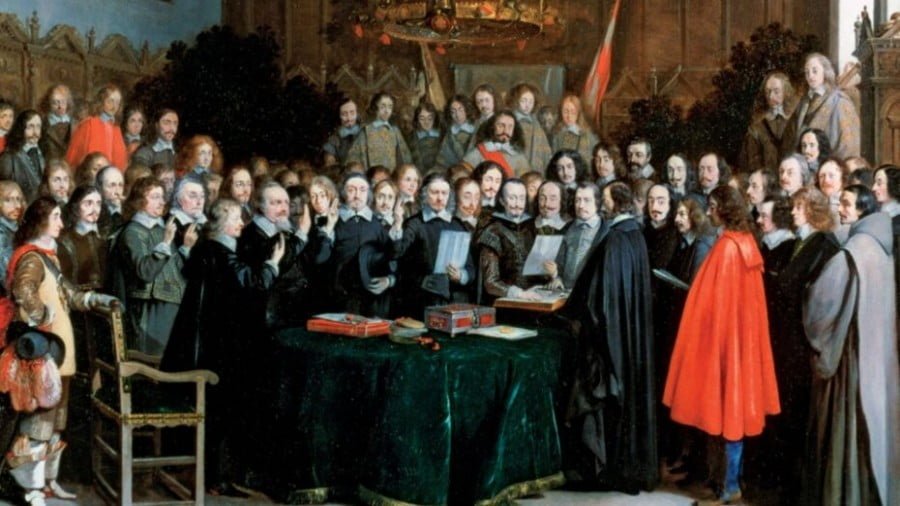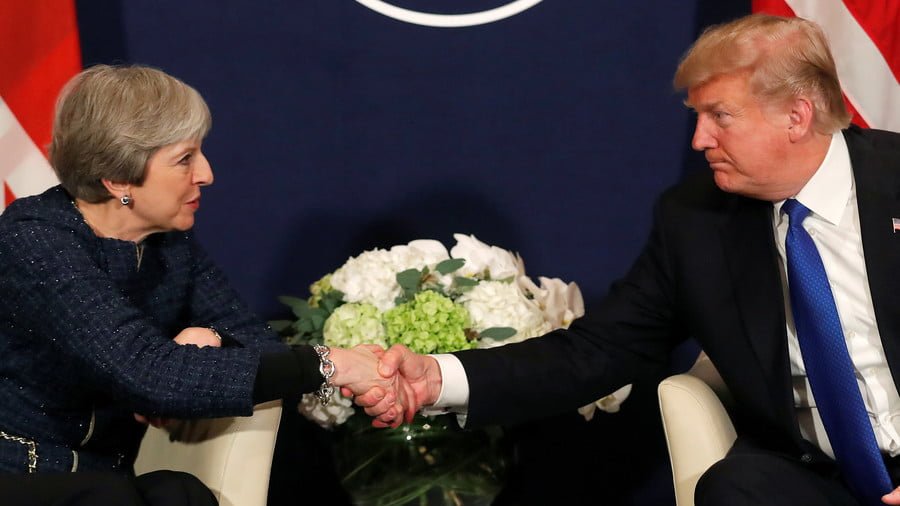Why the 1648 Westphalian Treaty Must Be Defended as a Remedy to the Unipolar ‘Rules-Based Order’
The Peace of Westphalia, just like the American Revolution that it inspired, and the UN Charter that served as its continuation is like garlic to the Vampires of today’s Wall Street and City of London.
The fact is that the Peace of Westphalia, just like the American Revolution that it inspired, and the UN Charter that served as a continuation of this creative evolutionary march towards progress is like garlic to the Vampires of today’s Wall Street and City of London.
In 1999, a seemingly innocuous speech occurred in Chicago that unveiled a new paradigm in world affairs that was dubbed “the Blair Doctrine”. In this speech, Blair asserted that the realities of the new age of terrorism had rendered the respect for sovereign nation states irrelevant and obsolete requiring a superior doctrine compatible with the need to periodically bomb sovereign nations you don’t like. This new age of humanitarian bombings would be called “the post-Westphalian age”.
Recalling this speech in 2004, Blair mused “before Sept. 11, I was already reaching for a different philosophy in international relations from a traditional one that has held sway since the Treaty of Westphalia in 1648; namely, that a country’s internal affairs are for it, and you don’t interfere unless it threatens you, or breaches a treaty, or triggers an obligation of alliance.”
By now, we all know the name for this unipolar doctrine and the smoldering wave of destruction and death that it justified for the ensuing two decades.
What is less understood is the nature of the Treaty of Westphalia of 1648 which Blair referred to as an obsolete doctrine in desperate need of replacing.
Since the 1648 Treaty of Westphalia set the foundations for the later UN Charter drafted by Franklin Roosevelt and Undersecretary of State Sumner Welles in 1941 [LINK] and since both this 1648 treaty and the UN Charter have been systemically targeted for destruction by Borg-like armies of “International Rule of Law” advocates pushing R2P and a Great Reset onto the world, let us take a moment to ask: What is the Treaty of Westphalia? How did it transform world history? And why is it’s defense so necessary in today’s crisis-ridden world?
The Peace of Westphalia: Phase Shift in World History
Before the Westphalian Treaty, Europe was bereft in chaos and war.
Not only did the Thirty Years War (1618-1648) eliminate over one third of the German population, but an additional century of religious war had set fire to Europe starting with the Knights Revolt of 1522 and the German Peasants War of 1524 that saw up to 300 thousand protestant peasants killed.
Before blowing up in Germany, Protestant vs Catholic wars had ravaged France between 1562-1598 during a devastating period of chaos that came to be known as “the Little Dark Age”, only coming to an end through the wise diplomatic maneuvers of King Henry IV of Navarre. It was Henry IV, along side his lead advisor Maximilien de Bethune (aka: Duke of Sully) who reformed France by establishing religious tolerance in the famous 1598 Edict of Nantes (removing Lutheranism and Calvanism from the list of heresies), while clamping down on corruption, banning usury, ending speculation, banning high rents and investing in internal improvements with a focus on textile manufacturing and agricultural reforms.

The burst of economic growth generated by these reforms doubled the revenues of France within 12 years and revived the spirit of the great nation-building king Louis XI turning France from a house divided in Civil War into a unified state that won the admiration of all the people of Europe (and the disdain of the financier oligarchy). Henry IV also clearly aimed to revive the traditions of the Great Charlemagne who was the last monarch to unite all of Europe under a common principle of law, when he said that Europe should become “a Christian republic, entirely peaceful within itself”.
Sadly, Henry IV’s murder by “a lone assassin” in 1610 left a power vacuum and soon the religious wars grew once again out of control in Europe. This time however, they were concentrated in the more fertile soils of the highly fragmented Holy Roman Empire then occupying most of today’s Germany, Austria, Czech Republic, and Poland. Unlike today’s Germany, the land that blew up in religious conflict during these dark years was dominated by small-minded warlord Princes and Dukes whose power was contingent on how many mercenaries they could hire and land they could steal. In total, over 350 tiny states and principalities existed along with 2000 jurisdictions which divided the Holy Roman Empire under an array of mini sovereignties with no conception of a greater whole. [see map]

To say that the 30 years war was of a purely religious nature is an over-simplified error that many are want to make.
As outlined brilliantly by historian Pierre Beaudry, throughout the conflict, Catholic Bourbons of France often used Protestant Proxies in Germany to fight Spanish (Catholic) Hapsburgs that were territorial rivals over low countries or Poland. Meanwhile the absence of any rules of territorial sovereignty welcomed constant infringement of factions onto each other’s lands. Austro-Hungarian Habsburg emperors constantly pushed expansionist policies and Venetian games were often played on the Baltic and Black Seas while both Venetian, Dutch and other purse strings were funding all warring sides throughout the years of chaos.
Needless to say, it was a disaster that was clearly sending Europe on a fast track towards a new dark age.
By 1609, the world’s first private central bank of Amsterdam was established along with the Dutch East India Company, which soon merged with the British East India Company and established a global maritime empire, where Venice had formerly been the dominant center of banking, world trade, controller of bullion and maritime choke points.
In reality, the same forces of Venice (and their sister “city state” of Genoa) were largely behind the reallocation of imperial command centers from the Venetian Levant Company to the Netherlands and thence to England (where the later takeover was finalized during the 1688 ‘Glorious Revolution’ and the 1694 founding of the Bank of England as I outlined in my article the Art of Political Lying.)

Realizing that a profound change was required to end this slide into hell, forces yearning to revive the policies of Louis XI and Henry IV and unite Europe in peaceful co-existence were organized around France’s Prime Minister Cardinal Jules Mazarin (1602-1661) and his young protégé Jean-Baptiste Colbert (1616-1683). Beginning in 1642, Mazarin began a tedious process of organizing for the Treaty of Westphalia offering to serve as peace broker, lead negotiator and guarantor of religious freedoms for all parties, finally arranging the signing to occur in two locations on October 24, 1648, where protestant signators met in Osnabrück and Catholic signators met in Münster.

The Benefit of the Other
Although the Treaty that established the framework for the sovereign nation state is often taught to students of political science as a messy legal protocol featuring 128 clauses designed to respect the rights of others to be left alone and not impinge onto territory that doesn’t belong to you, something very special is often left out of the equation. This something is a principle outlined in the first two articles which serve as a guiding pre-amble of sorts and which infuse vitality into the entire framework:
1) That all nations will now be guided by the concern for the benefit of their neighbors and 2) the forgiveness for all past transgressions. Since it is so rare that these articles are read in today’s world, let us review them here:
Article 1: “That there shall be a Christian and Universal Peace, and a perpetual, true, and sincere Amity… That this Peace and Amity be observ’d and cultivated with such a Sincerity and Zeal, that each Party shall endeavour to procure the Benefit, Honour and Advantage of the other; that thus on all sides they may see this Peace and Friendship in the Roman Empire, and the Kingdom of France flourish, by entertaining a good and faithful Neighbourhood.
Article 2: That there shall be on the one side and the other a perpetual Oblivion, Amnesty, or Pardon of all that has been committed since the beginning of these Troubles, in what place, or what manner soever the Hostilitys have been practis’d, in such a manner, that no body, under any pretext whatsoever, shall practice any Acts of Hostility, entertain any Enmity, or cause any Trouble to each other”
These were not pretty words on parchment applicable only to a “western European cultural matrix” as many believe, but foundational principles of natural law applicable to all civilizations and times. We need not look far to see their expression in the modern times not only in the UN Charter, but also the Five Principles of Peaceful Coexistence in 1954 which has come alive with the Eurasian Grand Design of win-win cooperation underlying the Belt and Road Initiative today.

The Economic Developments that Gave Vitality to the Peace
In the same measure that the Westphalian principles outlined in Articles one and two of the UN Charter were contingent upon the successful implementation of the international New Deal economic programs showcased at Bretton Woods, so too was the success of the Westphalian Treaty contingent upon the implementation of great public works and economic reforms that were only partially realized across Europe in the decades following 1648.
Before his death in 1661, Cardinal Mazarin outlined major infrastructure projects for both Germany and France which were directed towards developing of the internal powers of labor of the nations of Europe through canals, manufacturing and roads, while liberating European states from reliance on the Maritime monopolies of the Venetians, Dutch, Spanish and Genoese.
As Beaudry outlines in his Peace of Westphalia and the Water Question, chief among those canal projects outlined by Mazarin included:
- the Vistule River (through Silezia, Mazovia, and East Prussia discharging into the Black Sea),
- the Oder River Projects (discharging into Baltic Sea),
- the Elbe River development (Bohemia to North Sea via Dresden, Magdeburg and Leipzig),
- the Weser River program through middle Germany and
- the Rhine River (Switzerland, Germany, France, Netherlands).
Some of these projects like the Rhine-Maine-Danube Canal connecting the North and Black Sea were only accomplished 300 years after the Treaty of Westphalia, although Mazarin’s key German ally Friedrich William (The Great Elector of Brandenburg) who was chosen to lead the League of Rhine in 1759 spearheaded the growth of many of Mazarin’s canals and road designs along with his son Friedrich the Great.

One of the first preconditions Mazarin had at the start of the Westphalian treaty’s negotiation in 1642 was the ending of tolls on waterways imposed by narrow minded princes and dukes who held territorial controls over sections of river systems throughout Germany which made any economic development of the territory financially unviable. In an early agreement signed in 1642, Mazarin had dozens of princes agree that
“From this day forward, along the two banks of the Rhine River and from the adjacent provinces, commerce and transport of goods shall be free of transit for all of the inhabitants, and it will no longer be permitted to impose on the Rhine any new toll, open berth right, customs, or taxation of any denomination and of any sort, whatsoever.”
In France, one of the greatest infrastructure projects in history was begun under Mazarin and continued by his close collaborator Jean-Baptiste Colbert called La Canal Du Midi (aka: Languedoc Canal). This was a 240 km canal creating a direct passage between the Atlantic with the Mediterranean eliminating a 3000 km detour around the Spanish Habsburg-controlled Strait of Gibraltar [see map].
This program took 15 years to complete and involved the construction of 130 arched bridges, 75 locks, and the largest man-made reservoir in human history at the base of the Montagne Noire. This reservoir required new discoveries in engineering and science lifting six million cubic meters of water to an elevation of 190 meters above sea and accumulated water from several sources including underground rivers in order to feed by gravitational flow into the Garonne and Aude rivers flowing in two opposing directions.
It was this last challenge that had caused centuries of engineers to give up on the viability of the project which had been a struggle since the days of Ancient Rome. The vast improvements of water systems around the Languedoc turned the region into a breadbasket with wheat production and wines skyrocketing.

Colbert Drains the Swamp
Finance Minister Colbert unleashed one of the greatest crackdowns on corruption by forcing public audits of the aristocracy and auditing all financial officers who were obliged to prove where all of their possessions and even titles came from. The buying of titles was also a common practice in France as source of state revenue, and this cancerous growth of corruption was also intervened upon by Colbert who demanded an investigation into the legitimacy of all titles. By the end of this inquiry over 2000 claimed titles of nobility were deemed fraudulent whereby former nobles had to get real jobs and pay taxes.
One of the most important figures in France who faced justice under Colbert’s crackdown was the corrupt Superintendent of Finance Nicholas Fouquet who had looted France for millions over decades, even repaying himself for over six million pounds from state treasuries for loans that he had never made to the nation. Over the course of these 1661 trials, all of Fouquet’s skeletons were brought to light and he was imprisoned for life along with many leading collaborators of France’s deep state (resulting in Colbert’s receiving Fouquet’s position).
Colbert’s New Deal
With the swamp sufficiently flushed and France’s deep state reined in, Colbert launched a series of additional reforms which included the imposition of protective tariffs against British, Dutch and Belgian dumping of cheap goods, the directing of 5 million pounds of state credit to develop textiles and manufacturing, the founding of the Royal Academy of Sciences in 1666 inviting the greatest minds of Europe to France, the creation of the largest observatory in the world, the establishment of trade schools and masters programs, the boosting of national exports over imports, the extension of royal grants to private enterprises to build and manage internal improvements, and Colbert even established Europe’s first minimum hours of labor and health insurance for the 12,000 employees working on the Canal du Midi.

Colbert ended the purchasing of public offices (called “venal offices”), created a five year debt moratorium to re-organize the legitimate from usurious debt imposed upon France over the years by its local oligarchy, and passed laws that ensured that only the state could collect taxes and not private nobles.
Colbert lost no time in overhauling the over-bloated bureaucracy of France telling the young King Louis XIV:
“It is necessary to reduce the professions of your subjects as much as possible to those which can be useful to these grand designs… these are agriculture, merchandise [production and distribution of goods], soldiers and sailors… Your majesty should be working at the same time to diminish, gradually and insensibly the number of monks and nuns… the two professions which consume a hundred thousand of your subjects uselessly are financiers and lawyers.”
Colbert also drove ship building creating one of the world’s most advanced merchant fleets competing with the Dutch, Spanish and British, amplifying France’s defenses in border regions and increased war ships from 20 to 250 in twenty years.
The Westphalian Roots of the American Revolution
When formulating the principles upon which the new republic would be founded in 1781, Alexander Hamilton demonstrated his profound understanding of Colbertism as the key to the salvation of the new republic. When faced with the world’s largest empire which enjoyed near monopolies on manufacturing, banking, bullion and maritime trade, how would this young nation, having just emerged from the revolutionary war with no manufacturing, underdeveloped territory, unpayable debts be capable of standing on its own feet?
Writing in “The Continentalist” in 1782, Hamilton said:
“From a different spirit in the government, with superior advantages, France was much later in commercial improvements, nor would her trade have been at this time in so prosperous a condition had it not been for the abilities and indefatigable endeavors of the great Colbert. He laid the foundation of the French commerce, and taught the way to his successors to enlarge and improve it. The establishment of the woolen manufacture, in a kingdom, where nature seemed to have denied the means, is one among many proofs, how much may be effected in favor of commerce by the attention and patronage of a wise administration. The number of useful edicts passed by Louis XIV, and since his time, in spite of frequent interruptions from the jealous enmity of Great Britain, has advanced that of France to a degree which has excited the envy and astonishment of its neighbors.”
The system that Hamilton devised through his studies of Colbert’s dirigisme was outlined in his famous four reports to Congress of 1791-92 (Report on a National Bank, Report on Public Credit, Report on Manufactures and Report on a Mint) and went on to shape the minds of the greatest statesmen of both the USA and internationally for the next 240 years. It was known more clearly generations past as “the American System of Political Economy”.

This was the system that John Quincy Adams extended a foreign policy doctrine of a Community of Common Principle. This is the conception which animated Adams’ crafting of the Monroe Doctrine that sought to promote sovereign economic development of all American nations and blocking European imperial intrigue from infusing into the western hemisphere. Despite the abuses conducted under its name by imperialist US presidents later on, this remains the truth of its birth whether haters of the USA like it or not.
This system continued to grow under the wise guidance of Lincoln’s economic advisor Henry C Carey, and President McKinley whose 1901 assassination ushered in three decades of crippling insanity and corruption in the USA.
FDR as the 20th Century Colbert
This was the system that again emerged onto the scene with Franklin Roosevelt’s rise to power in 1932. As I outlined in my recent paper ‘How to Crush a Banker’s Dictatorship’, FDR lost no time reviving the policies of Colbert on every level- from his draining of the swamp during the Pecora commission, the breaking up of the Too Big To Fails, destruction of the London Banker’s Dictatorship, sabotage of the unipolar League of Nations, and commitment to destroy both fascism during WW2 and more importantly British colonialism more broadly.
When one reads the Atlantic Charter, UN Charter, Four Freedoms or Good Neighbor Policy outlined by FDR between 1936-1945, it is clear that the spirit of Westphalia burned strong in Franklin Roosevelt’s grand design for a multipolar world that was sabotaged before it had a chance to breath.
Many are quick to mock the Treaty of Westphalia for not having brought everlasting peace to Europe since wars obviously continued beyond 1648. Many imperial geopoliticans like Henry Kissinger, Robert Gates, or Brent Scowcroft even praise the treaty, but only for the most narrow-minded reasons which actually serves to do much more damage to the cause of the nation state system than those liberal imperialists who attempt to openly attack it like Tony Blair, George Soros, Lord Malloch Brown, Susan Rice or Samantha Power.
The fact is that the Peace of Westphalia, just like the American Revolution that it inspired, and the UN Charter that served as a continuation of this creative evolutionary march towards progress is like garlic to the Vampires of today’s Wall Street and City of London. For just as Colbert had the financier oligarchy of Europe’s black nobility to deal with, today’s sociopathic elite seek ends not divergent from their 17th century forebears who deny the inalienable rights of humankind from which the authority for law and national sovereignty is justly derived.
It is this oligarchical force now pushing an “international rules-based order” which has sought relentlessly to undo every great advance in the moral, intellectual and aesthetic progress of humankind since the Renaissance by returning society to a new feudal order with a technocratic spin which differs from the medieval dark age only by the vastly greater masses of people who will suffer and die in the 21st century.
The author recently delivered a lecture on this topic which can be viewed here:







